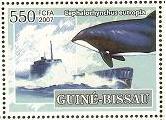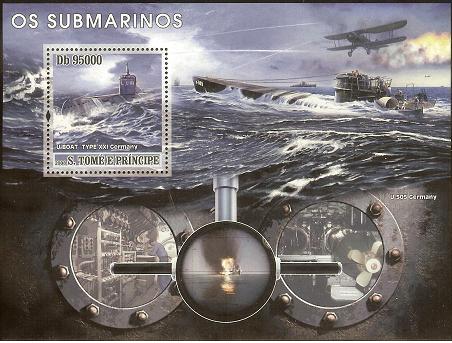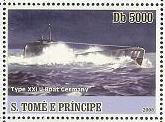|
U- Boat Type XXI, Kriegsmarine `Electroboote` of WW-II
 Type XXI U-boats, also known as "Elektroboote", were the first submarines designed to operate entirely submerged, rather than as surface ships that could submerge as a temporary means to escape detection or launch an attack. They were revolutionary when introduced and, if produced earlier and in sufficient quantity, could have seriously influenced the outcome of the Battle of the Atlantic. Type XXI U-boats, also known as "Elektroboote", were the first submarines designed to operate entirely submerged, rather than as surface ships that could submerge as a temporary means to escape detection or launch an attack. They were revolutionary when introduced and, if produced earlier and in sufficient quantity, could have seriously influenced the outcome of the Battle of the Atlantic.
At war end Allais were able to evaluate, examine and get familiar with some XXI models becoming later on the base for post war modern West and East submarine designs.
The key improvement in the type XXI was greatly increased battery capacity, roughly three times that of the Type VIIC. This gave these boats enormous underwater range, and dramatically reduced the time spent near the surface. They could travel submerged at about five knots for two or three days before recharging the batteries, which took less than five hours using the snorkel. The type XXI was also much quieter than the VIIC, making it more difficult to detect when submerged.
The type XXI`s streamlined and hydro-dynamically clean hull design allowed high submerged speed. The ability to outrun many surface ships while submerged, combined with improved dive times, made it much harder to chase and destroy.
The type XXIs had better facilities than previous classes, including a freezer for foodstuffs. Conveniences for the crew included a shower and a washbasin – crews on other boats spent weeks without bathing or shaving. The type XXI featured a hydraulic torpedo reloading system that allowed all six torpedo tubes, located in the bow, to be reloaded faster than a type VIIC could reload a single tube. The type XXI could fire 18 torpedoes in less then 20 minutes. The total war load was 23 torpedoes, or 17 torpedoes and 12 sea mines. The XXI featured an advanced sonar system which allowed aiming torpedoes without using the periscope, increasing stealth.
U-2511 and U-3008 were the only type XXIs to go on wartime patrol, and both failed to sink any ships. Most boats were scrapped or scuttled after the war, but eight were taken by the Allies for evaluation and trials.
Postwar
The United States received U-2513 and U-3008, which were commissioned into the United States Navy. U-3017 was commissioned into the Royal Navy as HMS N41, and U-2518 became French submarine Roland Morillot, which served until 1967.
Four type XXI boats were assigned to the Soviet Union by the Potsdam Agreement; these were U-3515, U-2529, U-3035, and U-3041, which were commissioned into the Soviet Navy as B 27, B 28, B 29, and B 30 respectively. However, Western intelligence believed the Soviets had acquired several more type XXI boats.
A ninth XXI also saw service after the war: U-2540, which had been scuttled at the end of the war, was raised in 1957 to become the research vessel Wilhelm Bauer of the Bundesmarine. It is the only restored type XXI and became a museum ship as part of the German Maritime Museum in Bremerhaven, Germany.
Influences
The type XXI design directly influenced USS Nautilus, the world`s first nuclear submarine, USS Albacore, the first submarine with a teardrop hull, the French Narval class submarine, the British Porpoise class submarine. Type XXI formed the basis for the Soviet Project 614 submarine, known by the NATO name Zulu, which was basically a copy of the type XXI, and many type XXI characteristics were also incorporated into the Project 613, the Whiskey class, although the Whiskey class was smaller and less sophisticated.
Specifications, Type XXI:
Displacement (srf/sub tons): 1,621/1,819
Dimensions (L*B*D feet/meter): 251’7*21’7*20’9/76.7*6.6*6.3
Propulsion: diesel-electric 2× MAN M6V40/46KBB supercharged 6-cylinder diesel engines, 4,000 hp, 2× SSW GU365/30 double acting electric motors, 5,000 hp, 2× SSW GV232/28 silent running electric motors, 226 hp, 3*124 battery cells, 2 shaft
Speed (srf/sub knots): 15.6/17.2
Range (srf/sub n/miles@knots): 15,500@10/350@5
Diving depth (feet/meter): max’ operating depth 656/200, crush depth 919/280
Complement: 57 officers and enlisted
Torpedo: 6*21"(533 mm) bow torpedo tubes, total of 23 torpedoes
Mines: 12*TMC in lieu of torpedoes
Armament: 2* twin 20/C30 mm AA guns
Construction
Between 1943 and 1945, 118 boats of this type were assembled by Blohm & Voss of Hamburg (45 units), AG Weser of Bremen (42 units), and F. Schichau of Danzig (31). The hulls were constructed from 8 prefabricated sections with final assembly taking place at the shipyards. This new method could have pushed construction time below six months per vessel, but in reality all the assembled U-boats were plagued with severe quality problems that required extensive post-production work to fix. The blame lay as much with the cutting-edge technology as with Albert Speer`s insistence that the sections be made by inland companies, even though these had little experience in shipbuilding. It would have made more sense to concentrate all construction at the shipyards, where the expertise was available to build sophisticated vessels. The extent of the industrial fiasco can be gauged by the fact that out of 118 assembled XXIs, only four were rated fit for combat before the war ended in Europe.
Back to History Index
 |
Guinea-Bissau |
2007 |
Type XXI, German submarine, SS |
 |
Saint Thomas |
2008 |
German U-Boat type XXI (souvenir sheet) |
 |
Saint Thomas |
2008 |
German U-Boat type XXI |
|